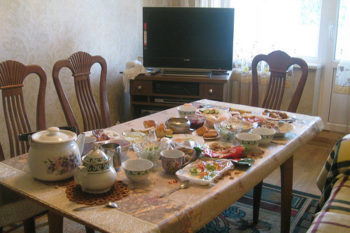On a recent trip to the beautiful Grand Bazaar in Istanbul, Turkey I was impressed to see the stall owners switch effortlessly from one language to another as they greeted customers from different countries. Of course it takes a lot of of practice to get to that level but learning to say ‘Hello’ is a good start.
The languages were chosen based on those known by PocketCultures and our friends, plus some others that came into our heads. They are grouped according to their language families. Obviously the main drawback of this list is that it only has 20 languages, so if yours isn’t there please tell us about it in the comments!
Indo-European Languages
This diverse and widespread language group includes most European languages as well as some from further East.
1. BONJOUR – French
Where to say it:
Apart from France, Belgium and Switzerland this will also be understood in Morocco, Tunisia and Algeria and the sub-Saharan African countries of DR Congo, Côte d’Ivoire, Cameroon, Guinea, Gabon and Mauritius.
2. HOLA – Spanish
Where to say it:
Outside Spain, Spanish, or Castillian as it is sometimes called, is the main language of all Central and South American countries apart from Brazil. It is also the second most common language in the USA, spoken by more than 34m Hispanic Americans.
3. HALLO / GUTEN TAG – German
Where to say it:
Germany, Austria and Switzerland
4. CIAO – Italian
Where to say it:
Italy
5. OLÀ – Portuguese
Where to say it:
Portugal and Brazil. Also spoken in former Portuguese colonies of Angola, Mozambique, Cape Verde, São Tomé and Macau.
6. NAMASTE – Hindi
Where to say it:
Northern India and Nepal. Hindi is one of the official languages of India, but is spoken as native language by only 41% of the population. Some people classify Hindi as the same language as Urdu, which is spoken in Pakistan.
7. SALAAM – Persian (Farsi)
Where to say it:
Iran, Afghanistan, Tajikistan. Also parts of Uzbekistan and Bahrain. NB. Persian is sometimes called Farsi. That’s the local name for Persian as it is spoken in Iran.
8. ZDRAS-TVUY-TE – Russian
Where to say it:
Russia, and as a first or second language in the Eastern European, Caucasian and Central Asian countries of the former USSR. Kazakhstan in particular has large numbers of ethnic Russians who speak Russian rather than Kazakh.
Ural-Altaic Languages
A controversial language family. Experts do not agree on which language family Japanese belongs to. We included it here in the Ural-Altaic family, but some linguists think it belongs better in the Austronesian family whilst others think it canot be classified. Likewise, there is some disagreement on whether Turkish and Korean belong to this group as well.
9. OHAYO / KONNICHIWA / KONBAN WA- Japanese
Where to say it:
Japanese is spoken pretty much only in Japan. The greetings above are used in the morning, around midday and in the evening respectively.
10. AHN-YOUNG-HA-SE-YO – Korean
Where to say it:
North and South Korea.
11. MERHABA – Turkish
Where to say it:
Turkish is spoken in Turkey and Cyprus. Also the languages spoken in Azerbeijan and parts of Iran, Georgia and the Balkans are very similar to Turkish.
12. SAIN BAINUU- Mongolian
Where to say it:
Mongolia. Mongolian speakers also live in some parts of Russia, China (Inner Mongolia) and Kyrgyzstan.
13. SALEMETSIZ BE? – Kazakh
Where to say it:
Almost 7 million of the world’s 10 million Kazakh speakers live in Kazakhstan. The rest are divided between Xinxiang province in China, Uzbekistan, Russia, Mongolia, Turkmenistan, Ukraine and Tajikistan. As in Mandarin, the literal translation of this greeting is ‘how are you?’
14. SZIA – Hungarian
Where to say it:
Mostly in Hungary, although parts of Austria and the Balkans have Hungarian speakers.
Afro-Asiatic Languages
These languages are spoken in North Africa and include the Berber languages spoken by desert nomads of the Sahara.
15. MARHABA – Arabic
Where to say it:
Arabic in various dialects is spoken throughout North Africa and the Middle East. It is a main language in the following countries: Algeria, Bahrain, Chad, Egypt, Eritrea, Iraq, Israel, Jordan, Kuwait, Lebanon, Libya, Mauritania, Morocco, Oman, Palestine, Qatar, Saudi Arabia, Somalia, Sudan, Syria, Tunisia, UAE, Western Sahara, Yemen
16. SANNU / SALAMA ALEIKUM – Hausa
Where to say it:
Hausa is the native language of inhabitants of Niger and Northern Nigeria, but it is also used as lingua franca in many countries of West and Central Africa.
Niger-Congo Languages
Most African languages belong to this group, which may be the largest in the world in terms of distinct languages.
17. JAMBO / HABARI – Swahili
Where to say it:
Swahili has between 5 and 10 million native speakers who mainly live in Tanzania, Uganda and Kenya. But it is used as a lingua franca for most of East Africa and second language speakers swell the ranks to a massive 80 million!
Sino Tibetan Languages
Like its name suggests, this family groups the languages of China and Tibet.
18. NI HAU – Mandarin
Where to say it:
Mandarin is the most spoken language in the world – it is spoken by at least 50% of China’s 1.3bn population.
19. NAY HOH – Cantonese (Yue)
Where to say it:
Southern China (especially Guangdong province), Hong Kong and Macau
Austronesian Languages
Mostly spoken on the islands of Southeast Asia and the Pacific, only a few Austronesian languages are spoken on mainland Asia.
20. HALO – Bahasa Indonesia
Where to say it:
Although there are over 300 different dialects spoken in Indonesia, Bahasa Indonesia is spoken by much of the population as a second language. It is also very similar to the Malay language of Malaysia.
So, now you can start a conversation in at least 20 countries! Now all you need is someone to talk to…
Is your language missing? Leave a comment and let us know.
Read More:
More about different world language families
The most difficult languages in the world
The Top 20 Languages of the World





In Dutch, you say “hallo” or “goedendag”. Dutch is spoken in Belgium and the Netherlands.
Hallo Inge! Thanks for telling us!
Thai
Sa wad dee khrub – if you’re a male
Sa wad dee kha – if you’re a female
Where to say it: Thailand
Thanks Tom! Good to know.
Comment: Excellent Enterprise!
Suggestion: In Tamil, VANAKKAM
It’s a good thing to know a little bit in other languages. “Hola, como esta?” = “Hello, how are you?” in Spanish.
how to say hello in HMONG is
“nyob zoo”
Thanks Melaanie. I didn’t know about the Hmong language.
How do you say hello in Algerian??? please answer ASAP! i cant find any information anywhere…
Sorry, I don’t know about Algerian but in Te Reo Maori (New Zealand) you can say “kia ora” or “tena koe” (to one person)”tena koutou” (to a group of people). In Samoan it’s “Talofa lava”. And in Fiji it’s “Bula!”
Hi Tiffany, I’m not an expert or anything like that but I recently read a travel book about Algeria. By Algerian, I presume you mean Arabic speaking Algerians. Well in this book the author tried several times to approach people with the traditional greeting “Asalaam alaikum” – “Peace be upon you” and was a bit surprised when people didn’t respond very well to it or just ignored her. Instead her companions said “Labas” – “Peace”, I think, and the response was very good and friendly so I would recommend that. On the other hand, French is widely spoken in Algeria so you could say “Bonjour monsieur/madame – ca va?” and that would be very friendly and well-received. I hope that helps.
It’s “Hallo” in Norwegian. And Danish. And Swedish) 🙂
That’s easy, for an English speaker 🙂
Thanks for stopping by Sophie!
In Romanian is “Buna” or “Salut”.
hello .. algeria is an arab country and the main languages is ARABIC and french so you can say ( marhaba or bounjor or alsalam alykom )
iwish that help =]
It’s yiasou in Greek and G’day in Australia
it’s kumusta in filipino and malin pagol kamo…
mga hamg na tawo ini kamo yun….it means i love you!!!!!!!!hehe or mahal kita
iska waran – how are you
Is that Somalian?
i don’t know
In POlish is “Cześć”
Hello, Im Doing A Project, And I Have To Have A Collage Of 30 Ways Of Saying Hello In Different Launguages, Can AnyOne Help Me?’
Namaskaram…means Hello in Telugu language(worlds top 15 th language speak by people)its a part of indian language..(80m people speaks officially this language)
Namaskaaram-Telugu which is 13th in the Ethnologue in 2011 rankings.
Amharic is missing
this is how you say in Amharic : Selam
Aloha— Hawaiian
Lol, the timing seems to be different from my time. Now its 11:03p.m. in my country
In czech, you say “ahoj”
And in Slovak, you say “Ahojte”
Hello, I take mandarin Chinese and you don’t say Ni Hau its Ni Hao Correction so don’t put up something you don’t know. Please change it so the whole world wont be mislead.
Hi Karrington! Thanks for commenting. I guess to be correct we should have spelt it with Chinese characters 🙂 Good luck with your studies.
you forgot
portugese
Vietnamese:
“xin chào” or “chào” to everyone
“chào chị” to female
“chào anh” to male
In Guam, the language is CHamorro and we say “Hafa Adai
This was so helpful oh my goodness, thank you! I had a project about culture and we were told a goof way of expressing our knowledge was through language so I did hello in about 50 languages for my title page. thank you
Wana-kam in Tamil language (The pronounciation is easy like you say “Wanna come” together) 😛
Namash-car in Sanskrit.
Koni-chi-wa in Japanese.
Parev in Armenian language